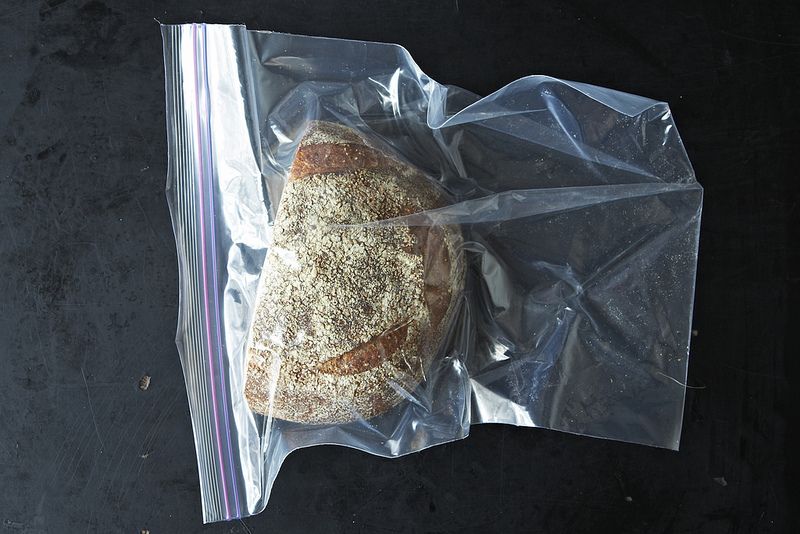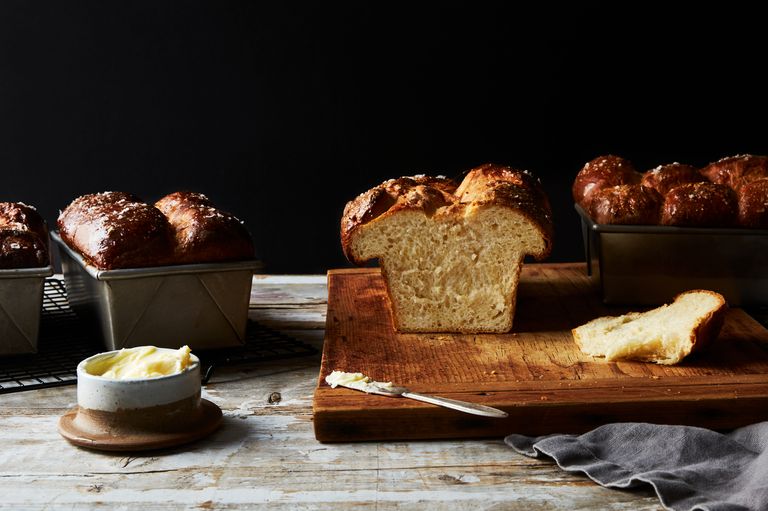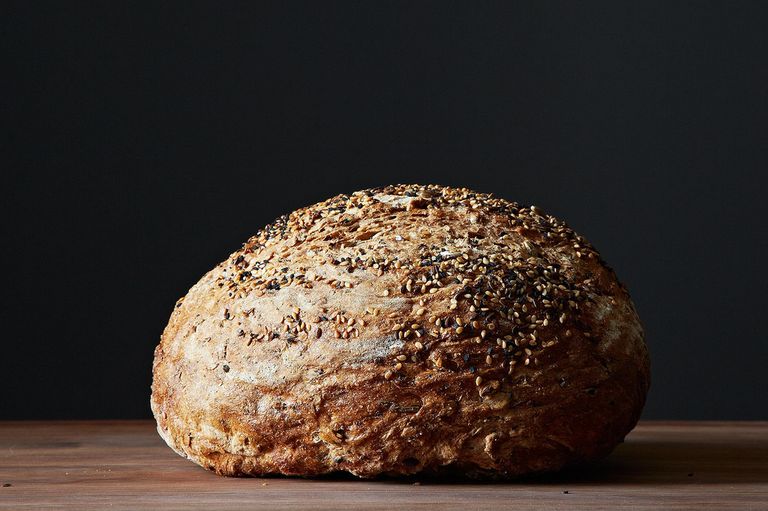Storage Tips
The Very Best Ways to Store Fresh Bread
Plus, the storage method that actually makes bread go stale faster.
Photo by James Ransom

It's here: Our game-changing guide to everyone's favorite room in the house. Your Do-Anything Kitchen gathers the smartest ideas and savviest tricks—from our community, test kitchen, and cooks we love—to help transform your space into its best self.
Grab your copyPopular on Food52
30 Comments
TGard
January 29, 2021
I have found the best way to keep bread "fresh" for a couple extra days is to store it in one of those green bags that are used to keep your veggies fresh. These bags have a certain level of porosity so that the bread breathes but doesn't get hard. Left in the brown paper bag over night I usually put it in a green bag the next morning.....after toasting a couple hunks for an exceptionally delicious egg sammich. And I do leave it in the original brown bag as well. The crust will soften using this method as well.
Leslie G.
January 29, 2021
As soon as I bring artisan breads home, I store them in my Staub or other Dutch oven.
A bread baker shared this tip, and it works really well. I suggest removing them from plastic bags as that can speed mold.
A bread baker shared this tip, and it works really well. I suggest removing them from plastic bags as that can speed mold.
Isabel
August 30, 2020
Best technique I’ve devised for my small kitchen is to put the bread in a paper bag, and then put that inside a ziploc-type plastic bag. (I actually use plastic bags from a bakery -they’re the same thickness of plastic but don’t have the total seal. I think it’s the thickness of plastic that matters, not being totally airtight.) I like that the whole package shrinks as the loaf gets smaller, and when I don’t have any bread, my counter space is freed up. Paper bag alone slowed the staling process, but not by much. Plastic bag alone - wherever the bread was in contact with the plastic, too moisture and then mold... the combo of paper and plastic works really well.
I also tend to freeze half the loaf as soon as I’m home from the bakery. I don’t pre-slice, just do it in chunks. Wrap tightly in foil, then again with the plastic bag, this time making sure to squeeze all air out. Thaw a chunk of bread, then slice as needed, storing on the counter as described in previous paragraph.
I also tend to freeze half the loaf as soon as I’m home from the bakery. I don’t pre-slice, just do it in chunks. Wrap tightly in foil, then again with the plastic bag, this time making sure to squeeze all air out. Thaw a chunk of bread, then slice as needed, storing on the counter as described in previous paragraph.
Carel H.
August 29, 2020
I was quarantining and had a little fridge with a chiller on top, instead of a freezer. We have a fab bread co here, and if I put the slices in a plastic bag in the chiller part they kept perfectly.
Frish B.
August 10, 2020
One addition to the cutting board approach: wet the wooden cutting board. Then place cut side down of loaf on the board and cover with a paper 'hat.' Almost miraculous.
Edwin R.
August 8, 2020
My favorite use of almost stale and stale sour dough bread is to make sopa de ajo (garlic soup). It's fast, easy and delicious.
isacello
August 7, 2020
I place mine on a wooden board cut side down so it won't dry out and place a small brown paper bag over it. I ask at the bakery if they can place it in a waxed paper bag which to me is the favorite to place over the cut bread resting on the board.
Barbara A.
August 7, 2020
I wrap my bread in plastic wrap then put into the paper bag. When I want to use it, I put it in the toaster oven on a broil setting and it crisps right up.
Amy W.
August 3, 2020
We use a linen bag. Plastic bags worked but mold crept in after a few days. We don’t have space for a bread box. The linen bag was a complete game changer. Our corner Italian restaurant turned into a bread bakery at the beginning of quarantine. We’ve had fresh bread every week since. We tried all sorts of storage methods to make the bread last as long as possible. Now we make it all the way to the next loaf with a crusty exterior and a soft interior. So delighted in the linen bags.
GabrielleS
August 8, 2020
It's funny, we got our linen bags right here at Food52--I was surprised they weren't mentioned. Maybe they don't carry them any more? Definitely my favorite as well.
But a linen or cotton dish towel works as well. I also try to balance the cut side down on the counter, or sometimes cover the open end slice with foil before putting in the linen bag.
But a linen or cotton dish towel works as well. I also try to balance the cut side down on the counter, or sometimes cover the open end slice with foil before putting in the linen bag.
lucida-bista
February 11, 2020
Just wanted to say a great option for bread that is already hard is French Toast!
Fun fact, obviously in France there's no french toast, but there is something quite similar called Pain perdu (literally "lost bread"), which is basically french toast but with hard bread, and you leave it soaking for longer. I guess with baguettes lasting so little, they had to come up with something ahaha.
But yeah, great solution. My go-to for hard bread.
Fun fact, obviously in France there's no french toast, but there is something quite similar called Pain perdu (literally "lost bread"), which is basically french toast but with hard bread, and you leave it soaking for longer. I guess with baguettes lasting so little, they had to come up with something ahaha.
But yeah, great solution. My go-to for hard bread.
Sarah S.
January 26, 2017
I'm planning on getting fresh bread and want to make sure that I store it correctly. I had no idea that a ceramic bread box allows for the ideal air circulation to keep your bread good. It would also be smart to make sure that you buy and eat bread from a reputable place. That way, you can be sure that it will last well. http://www.klostermanbakery.com/products/
Candace D.
June 1, 2015
I appreciate what you're doing on this site. I live in the Ohio Valley, and the humidity and temperature swings here can affect food viability. Mostly I just sigh heavily and go to the trash can to dump stuff. Please keep up the good work.
Mares
April 7, 2015
We place homemade artisan bread cut side down on a plastic cutting board and slip a jacket over it. We make the jacket from empty cereal box liners or from waxed paper, using staples or tape. Do not fully enclose the loaf. Just slip the waxed bag over the bread until it reaches the cutting board, like slipping on a toaster cover or stand mixer cover. Fold down any excess above the bread. This keeps the crumb fresh and the crust crunchy. The bag can be used/reused until it's worn out. If we bake multiple loves at one time, we cool them completely, double wrap in foil and freeze until needed. When needed, place directly from freezer into a 350 degree oven for 20 to 30 minutes, remove from oven, unwrap and it's like fresh baked bread....lovely moist crumb and crunchy crust. We live in a very dry climate at over 7,000 ft altitude. Never tried this in a humid environment.
Sandy M.
March 23, 2015
I store my bread in the microwave...it keeps fresh for a really long time (because the microwave is airtight, I think)!
sindhu C.
October 24, 2014
for years I have been storing over left bread in freezer, without any problem.specially sliced loaf bread,which is easy to pull out the needy required daily slices from the freeze
deb
June 5, 2014
slice it, wrap pieces in foil, store in ziploc in the freezer, and when I need to eat it, remove foil wrapped pieces from the ziploc, pop into oven for 20 mins. on 400 deg. and it's soft on inside and still crunchy on outside! Works every time!
Amy F.
June 4, 2014
I bake my own sour dough etc for sailing trips that take a week or more... we preserve our breads by brushing vinegar on the crust and turning the cut side down..I learned this on an Italian sail boat sailing from Panama to Colombia...
Neville
November 21, 2013
I travel a fair distance for my bread (lean) so preservation is somewhat a necessity. I have been bringing multiple loaves home, vacuum-sealing with the food-saver system. I am able to extend the life of the loaf for weeks in the freezer with little appreciable deterioration of texture or taste.
BurgeoningBaker
October 11, 2013
Actually if you put your bread in a brown paper bag. It will get hard and crusty.




/3467caac-08ef-40f3-ba0a-416b1d154daa--2019-1107_sponsored_miele_sourdough_3x2_bobbi_lin_27514.jpg)

/d2af6e2b-63e8-427a-a2f3-8ffc2d4b1eec--048_Staf_9780553459838_art_r1_1-.jpg)

/104b8c6e-0aee-4063-aea8-3117239dbadd--2017-1214_edward-lee-popcorn-bread_3x2_bobbi-lin_5349.jpg)

See what other Food52 readers are saying.